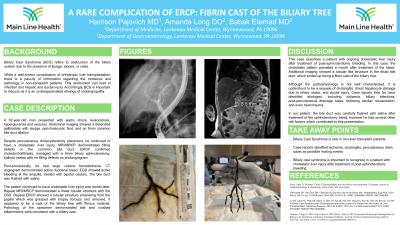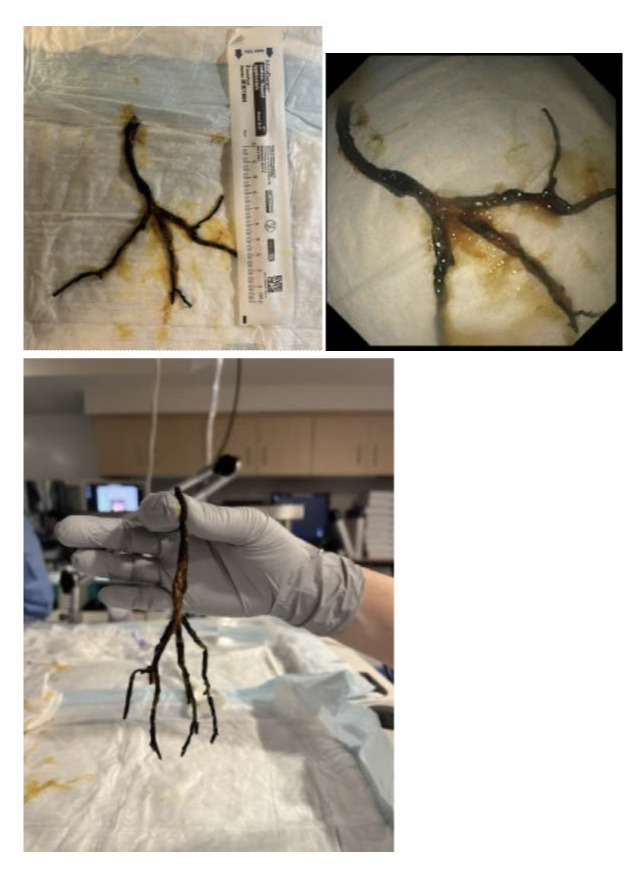Sunday Poster Session
Category: Biliary/Pancreas
P0091 - A Rare Complication of ERCP: Fibrin Cast of the Biliary Tree After Post-Sphincterotomy Bleeding
Sunday, October 27, 2024
3:30 PM - 7:00 PM ET
Location: Exhibit Hall E

Has Audio

Harrison Pajovich, MD
Lankenau Medical Center
Philadelphia, PA
Presenting Author(s)
Award: Presidential Poster Award
Harrison Pajovich, MD1, Amanda Long, DO2, Babek Etemad, MD2
1Lankenau Medical Center, Philadelphia, PA; 2Lankenau Medical Center, Wynnewood, PA
Introduction: Biliary Cast Syndrome (BCS) refers to obstruction of the biliary system due to the presence of sludge, stones, or casts. While a well-known complication of orthotropic liver transplantation, there is a paucity of information regarding the incidence and pathology in non-transplant patients. This obstruction can lead to infection and hepatic and ductal injury. Accordingly, BCS is important to discuss as it is an underappreciated etiology of cholangiopathy.
Case Description/Methods: A 62-year-old man presented with septic shock, leukocytosis, hyperglycemia and seizures. Abdominal imaging showed a distended gallbladder with sludge, pericholecystic fluid, and an 8mm common bile duct dilation. Despite percutaneous cholecystostomy placement, he continued to have a cholestatic liver injury. MRI/MRCP demonstrated filling defects in the common bile duct. ERCP confirmed choledocholithiasis, managed with a 9mm biliary sphincterotomy, balloon sweep with no filling defects on cholangiogram. Post-procedurally, he had large volume hematochezia. CT angiogram demonstrated active duodenal bleed. EGD showed active bleeding at the ampulla, treated with bipolar cautery. The bile duct was flushed with saline. The patient continued to have cholestatic liver injury one month later. Repeat MRI/MRCP demonstrated a linear tubular structure with the CBD. Repeat ERCP showed a tubular structure emanating from the papilla which was grasped with biopsy forceps and removed. It appeared to be a cast of the biliary tree with fibrous material. Pathology of the specimen demonstrated bile and crushed inflammatory cells consistent with a biliary cast.
Discussion: This case describes a patient with ongoing cholestatic liver injury despite percutaneous cholecystectomy placement and ERCP without filling defects. These images provide an example of an intra- and extrahepatic biliary casts due to post-ph. Although the pathophysiology is not well characterized, it is understood to be a sequela of cholangitis, direct hepatocyte damage due to biliary stasis, and ductal injury. Case reports thus far have identified etiologies, including ischemia, biliary infections, post-percutaneous drainage tubes, following cardiac resuscitation, and even head trauma. In conclusion, this case is an example of delayed BCS in a patient presenting with septic shock and persistent cholestatic liver injury potentially due to ischemia following percutaneous tube placement or direct biliary damage following ERCP.

Disclosures:
Harrison Pajovich, MD1, Amanda Long, DO2, Babek Etemad, MD2. P0091 - A Rare Complication of ERCP: Fibrin Cast of the Biliary Tree After Post-Sphincterotomy Bleeding, ACG 2024 Annual Scientific Meeting Abstracts. Philadelphia, PA: American College of Gastroenterology.
Harrison Pajovich, MD1, Amanda Long, DO2, Babek Etemad, MD2
1Lankenau Medical Center, Philadelphia, PA; 2Lankenau Medical Center, Wynnewood, PA
Introduction: Biliary Cast Syndrome (BCS) refers to obstruction of the biliary system due to the presence of sludge, stones, or casts. While a well-known complication of orthotropic liver transplantation, there is a paucity of information regarding the incidence and pathology in non-transplant patients. This obstruction can lead to infection and hepatic and ductal injury. Accordingly, BCS is important to discuss as it is an underappreciated etiology of cholangiopathy.
Case Description/Methods: A 62-year-old man presented with septic shock, leukocytosis, hyperglycemia and seizures. Abdominal imaging showed a distended gallbladder with sludge, pericholecystic fluid, and an 8mm common bile duct dilation. Despite percutaneous cholecystostomy placement, he continued to have a cholestatic liver injury. MRI/MRCP demonstrated filling defects in the common bile duct. ERCP confirmed choledocholithiasis, managed with a 9mm biliary sphincterotomy, balloon sweep with no filling defects on cholangiogram. Post-procedurally, he had large volume hematochezia. CT angiogram demonstrated active duodenal bleed. EGD showed active bleeding at the ampulla, treated with bipolar cautery. The bile duct was flushed with saline. The patient continued to have cholestatic liver injury one month later. Repeat MRI/MRCP demonstrated a linear tubular structure with the CBD. Repeat ERCP showed a tubular structure emanating from the papilla which was grasped with biopsy forceps and removed. It appeared to be a cast of the biliary tree with fibrous material. Pathology of the specimen demonstrated bile and crushed inflammatory cells consistent with a biliary cast.
Discussion: This case describes a patient with ongoing cholestatic liver injury despite percutaneous cholecystectomy placement and ERCP without filling defects. These images provide an example of an intra- and extrahepatic biliary casts due to post-ph. Although the pathophysiology is not well characterized, it is understood to be a sequela of cholangitis, direct hepatocyte damage due to biliary stasis, and ductal injury. Case reports thus far have identified etiologies, including ischemia, biliary infections, post-percutaneous drainage tubes, following cardiac resuscitation, and even head trauma. In conclusion, this case is an example of delayed BCS in a patient presenting with septic shock and persistent cholestatic liver injury potentially due to ischemia following percutaneous tube placement or direct biliary damage following ERCP.

Figure: Cast of the biliary tree removed via forceps endoscopically
Disclosures:
Harrison Pajovich indicated no relevant financial relationships.
Amanda Long indicated no relevant financial relationships.
Babek Etemad indicated no relevant financial relationships.
Harrison Pajovich, MD1, Amanda Long, DO2, Babek Etemad, MD2. P0091 - A Rare Complication of ERCP: Fibrin Cast of the Biliary Tree After Post-Sphincterotomy Bleeding, ACG 2024 Annual Scientific Meeting Abstracts. Philadelphia, PA: American College of Gastroenterology.

